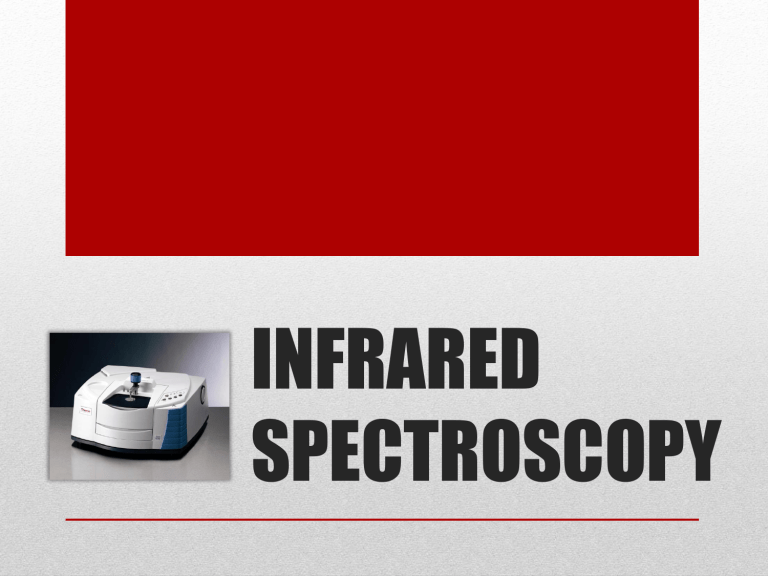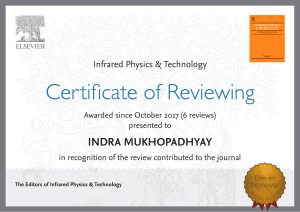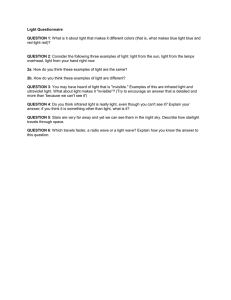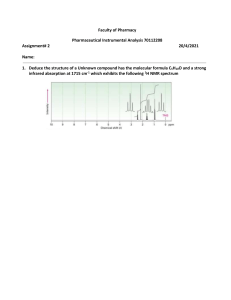
INFRARED SPECTROSCOPY What is Infrared Spectroscopy? • Is the spectroscopy that deals with the infrared region of the electromagnetic spectrum, that is light with a longer wavelength and lower frequency than visible light. • It is a method of measurement of the extent, at a various wave numbers, of absorption of infrared radiation when it passes through a layer of substances. • Infrared Spectrometer determines the wavelength and absorbance of a sample in the infrared region of the electromagnetic spectrum. Infrared Spectrometer • Different groups absorb at different wavelengths--characteristic frequencies. Carbonyl groups absorb at certain frequencies, primary amines at others, phenyl groups at still others, and so on. Functional Groups • The infrared spectrum is divided into three portions, near, mid, and far infrared, covering wave numbers (related to frequency) from 10-14,000 cm⁻¹. The range 500 - 4000 cm⁻¹ is used for basic laboratory work. 4000 cm-1 2700 cm-1 2000 cm-1 IR Frequency Range 1600 cm-1 400 cm-1 The IR Spectroscopic Process 1. The quantum mechanical energy levels observed in IR spectroscopy are those of molecular vibration 2. We perceive this vibration as heat 3. When we say a covalent bond between two atoms is of a certain length, we are citing an average because the bond behaves as if it were a vibrating spring connecting the two atoms 4. For a simple diatomic molecule, this model is easy to visualize: 5. There are two types of bond vibration: • Stretch – Vibration or oscillation along the line of the bond H H C C H H asymmetric symmetric • Bend – Vibration or oscillation not along the line of the bond H H H C C C in plane H C H H H H scissor rock twist wag out of plane 6. As a covalent bond oscillates – due to the oscillation of the dipole of the molecule – a varying electromagnetic field is produced. 7. The greater the dipole moment change through the vibration, the more intense the EM field that is generated. 8. When a wave of infrared light encounters this oscillating EM field generated by the oscillating dipole of the same frequency, the two waves couple, and IR light is absorbed 9. The coupled wave now vibrates with twice the amplitude IR beam from spectrometer “coupled” wave EM oscillating wave from bond vibration Uses and Applications • It is also used in forensic analysis in both criminal and civil cases, for example in identifying polymer degradation. • Chemical Analysis: Testing Pill Quality. According to "Medical News Today," scientists at the University of Maryland have been successful in using the method of near-infrared spectroscopy (NIR) to make a prediction regarding quick dissolution of pills inside the body. The success of the experiment can help drug manufacturers in checking the quality of pills to benefit consumers in the health industry. • Chemistry Applications. Using infrared spectroscopy, it is possible to measure the degree of polymerization in chemical compounds. Polymerization happens when monomer molecules undergo chemical reaction to form polymer chains. Infrared spectroscopy can measure the changes in the nature and quantity of molecular bonds. Portable instruments that can measure infrared spectroscopy are used in field trials. This method is important for researchers in identifying more uses of different substances to improve the lives of modern society. Medical breakthroughs are not far behind. The analysis of molecular compounds can lead to the discovery of new chemical compounds that can produce useful products.





